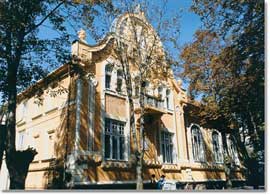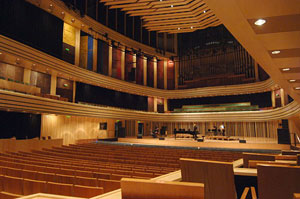|
Whitsun in Budapest
La bohème & Mágnás Miska in Budapest & a recital in Kaposvár
Whitsun, May 2008
Budapest, bisected by the Danube, presents a dramatic panorama. The terrain rises steeply on one side allowing the skyline to be dominated by the fortress of Buda castle, nicely balanced by the opulence of the Parliament built in respendant gothic revival style, on the commercially active Pest side of the river. The architecture reflects the diversity of the city’s culture, with classical and baroque styles intermixed with Ottoman influences.
At the ultra-modern National Concert Hall [pictured R] Puccini’s La bohème was semi-staged but that not in any way implying a reduced production. Props were minimal but the platform was  large enough to accommodate the full activity of the Café Momus sequence, complete with on stage band. The scene was set very effectively by video projections of sketches of Paris, which neatly incorporated efficient surtitles. The Hungarian State Opera House orchestra, chorus and children’s chorus were joined an international cast of young singers led by Alfred Kim as Rudolfo, a South Korean tenor of real promise, and Svetla Vassileva as Mimi. Boris Statsenko (Marcello) had an unfortunate tendency to over-sing which emphasised the lack of vocal strength of his Musetta (Eszter Wierdl). However, both Ádám Horváth (Schaunard) and András Palerdi (Colline) impressed favourably. The orchestra were in robust mood, and the acoustics of the hall were impressive. large enough to accommodate the full activity of the Café Momus sequence, complete with on stage band. The scene was set very effectively by video projections of sketches of Paris, which neatly incorporated efficient surtitles. The Hungarian State Opera House orchestra, chorus and children’s chorus were joined an international cast of young singers led by Alfred Kim as Rudolfo, a South Korean tenor of real promise, and Svetla Vassileva as Mimi. Boris Statsenko (Marcello) had an unfortunate tendency to over-sing which emphasised the lack of vocal strength of his Musetta (Eszter Wierdl). However, both Ádám Horváth (Schaunard) and András Palerdi (Colline) impressed favourably. The orchestra were in robust mood, and the acoustics of the hall were impressive.
The Grand Hall of the Franz Liszt Music Academy, with its elaborate dark green and gold decoration and superb acoustic, is a justifiably popular performing venue for the city’s professional orchestras. Students of the academy have free access to the upper balcony, whilst a smartly dressed paying audience fill the remainder of the house. On 9 May the Budapest Festival Orchestra, conducted by Ludovic Morlot celebrated the 100th Birthday of Elliott Carter with the first Hungarian performance of his Three illusions for Orchestra: Don Quixote; the legendary Fountain of Eternal Youth and Thomas More's Utopia. With masterly economy the piece lasts barely 10 minutes yet is almost symphonic scale; densely scored for a large orchestra with an impressive percussion section filling a gallery above the main platform. After the interval Berlioz’ Symphonie fantastique; sandwiched between the two a virtuoso performance of Schumann’s Violin Concert from the rising young French violinist Renaud Capucon.
The highlight of my weekend was a rare chance to see operetta in its home surroundings performed with light hearted zest. Budapest’s Operettszinhaz is located in an elegant boulevard in the heart of the theatre district. Purpose built in 1922, and lovingly restored, its glittering chandeliers, velvet wall covering and gilded stucco decorations add the finishing touches of glamour to the occasion. The theatre runs on the repertory system with a dozen or so productions overlapping. I caught Mágnás Miska (Mike the Magnate) by Albert Szirmai, one of the trio of composers at the heart of the Hungarian operetta tradition. Later in life he moved to New York changing his name to Sirmey and joined the music publishing houses of Harms and Chappells where many of the Broadway scores of Cole Porter and Richard Rodgers came under his editorial guidance.
A stable lad Miska (Imre Bajor) and his girlfriend Marcsa (Marika Oszvald), a laundress, unwittingly masquerade as ungainly members of the nobility, whilst an outrageous real life countess (Zsuzsa Lehoczky) confuses the plot still further with her light fingered misappropriation of every valuable in sight. The comedy was delivered with practiced spot-on timing and wafted along by a succession of seductive tunes. The ball scene delivered a swirling waltz followed by a lively folkdance, Hoppsza, Sári. A spirited orchestra, graceful costumes, and an audience who clearly loved every minute. provided the final touches. My ticket provided entry to the elegant VIP lounge, where the tables were discreetly marked with seat numbers and laid out with interval snacks and glasses of sparkling wine – truly an occasion to remember.
My Whitsun visit was completed by a short break at Kaposvár, a peaceful ‘picture pretty’ county town in the unspoilt countryside of southern Hungary. During the 19th and 20th century it attracted many of Hungary’s principal painters whose villa-studios are now open to the public. At the Liszt Ferenc Music School [pictured top L] soprano Alinka Kozári, one of their former pupils who has recently rounded off her studies at Britain’s National Opera Studio, had returned to give a benefit concert accompanied by pianist Kálmán Kardos. Her programme encompassed operatic arias from Handel to Stravinsky, with the bel canto repertoire of Donizetti and Bellini well represented and beautifully sung. This was one of those occasions when everything goes perfectly, with the capacity audience completely overwhelmed by both the singer and by the music itself. Alinka Kozári‘s encore, Oh! Mio babbino caro, was the icing on the cake for her delighted family.
Serena Fenwick
|

